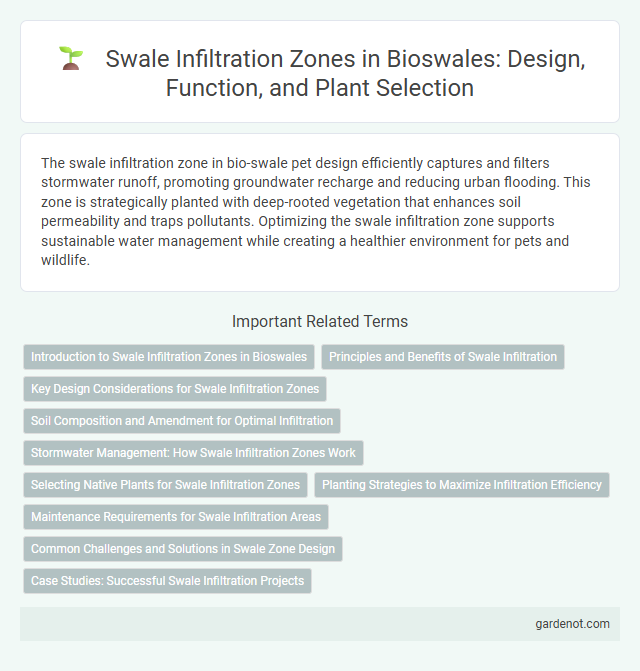The swale infiltration zone in bio-swale pet design efficiently captures and filters stormwater runoff, promoting groundwater recharge and reducing urban flooding. This zone is strategically planted with deep-rooted vegetation that enhances soil permeability and traps pollutants. Optimizing the swale infiltration zone supports sustainable water management while creating a healthier environment for pets and wildlife.
Introduction to Swale Infiltration Zones in Bioswales
Swale infiltration zones are engineered areas within bioswales designed to capture and absorb stormwater runoff, enhancing groundwater recharge and reducing surface water flow. These zones utilize permeable soils and vegetation to promote infiltration, improve water quality by filtering pollutants, and mitigate urban flooding. Integrating swale infiltration zones in green infrastructure supports sustainable stormwater management and ecosystem restoration.
Principles and Benefits of Swale Infiltration
Swale infiltration zones utilize permeable soil and vegetation to capture and absorb stormwater runoff, promoting groundwater recharge and reducing surface water flow. These zones implement principles of infiltration, filtration, and detention, mitigating pollutant loads by allowing sediments and contaminants to settle and degrade naturally. Benefits include decreased urban flooding, improved water quality, and enhanced ecosystem health by maintaining natural hydrologic cycles and supporting biodiversity.
Key Design Considerations for Swale Infiltration Zones
Swale infiltration zones require careful consideration of soil permeability, slope gradient, and vegetation type to maximize stormwater absorption and minimize runoff. Ensuring a minimum soil infiltration rate of 0.5 inches per hour and designing gentle side slopes of less than 4:1 promotes effective water infiltration and reduces erosion risks. Incorporating native vegetation with deep root systems enhances soil structure and microbial activity, further improving infiltration capacity and pollutant removal efficiency.
Soil Composition and Amendment for Optimal Infiltration
The swale infiltration zone relies heavily on soil composition, typically favoring sandy loam with high porosity to maximize water absorption and percolation. Soil amendments such as compost and biochar are frequently integrated to enhance organic matter content, improve soil structure, and increase microbial activity, which collectively boost infiltration rates. Properly amended soils mitigate runoff and promote groundwater recharge, ensuring effective stormwater management in bio-swale applications.
Stormwater Management: How Swale Infiltration Zones Work
Swale infiltration zones manage stormwater by capturing and filtering runoff through engineered depressions filled with permeable soil and vegetation. These zones promote groundwater recharge by allowing water to percolate slowly into underlying aquifers, reducing surface runoff and minimizing flood risks. Vegetative media in the swale also trap pollutants and sediments, enhancing water quality before infiltration.
Selecting Native Plants for Swale Infiltration Zones
Selecting native plants for swale infiltration zones enhances soil permeability and supports local biodiversity by promoting deep root systems that improve water absorption and reduce erosion. These plants are adapted to local climate conditions, requiring less maintenance and increasing the swale's efficiency in managing stormwater runoff. Prioritizing species such as native grasses, sedges, and wildflowers ensures optimal infiltration rates and ecological resilience in bio-swale environments.
Planting Strategies to Maximize Infiltration Efficiency
Swale infiltration zones benefit from strategic planting with deep-rooted native grasses and perennials that enhance soil permeability and promote water absorption. Selecting species with high transpiration rates and tolerance to periodic saturation improves infiltration efficiency by maintaining soil structure and reducing surface runoff. Implementing diverse plant assemblages supports soil microbial activity, further facilitating nutrient cycling and sustainable water management in bio-swales.
Maintenance Requirements for Swale Infiltration Areas
Swale infiltration zones require regular maintenance to ensure optimal water absorption and pollutant removal. Scheduled inspections should remove accumulated sediment, debris, and invasive vegetation to prevent clogging and maintain soil permeability. Proper upkeep includes monitoring soil moisture, repairing erosion, and managing plant health to sustain effective stormwater infiltration.
Common Challenges and Solutions in Swale Zone Design
Swale infiltration zones often face challenges such as soil compaction, inadequate infiltration rates, and sediment buildup that reduce water absorption efficiency. Solutions include incorporating engineered soil blends with high permeability, regular maintenance to remove sediment, and designing underlying drainage layers to prevent waterlogging. Proper vegetation selection also enhances infiltration by stabilizing soil and promoting microbial activity.
Case Studies: Successful Swale Infiltration Projects
The Swale Infiltration Zone design in bio-swales has demonstrated remarkable efficacy in multiple case studies, notably reducing stormwater runoff and enhancing groundwater recharge. For instance, the University of California, Davis project reported a 75% reduction in peak runoff volume and significant improvement in water quality by capturing pollutants in the swale infiltration zone. Similarly, the City of Portland's Tryon Creek Watershed initiative showcased scalable bio-swale infiltration systems that managed urban stormwater sustainably by integrating native vegetation and engineered soil layers.
Swale infiltration zone Infographic

 gardenot.com
gardenot.com